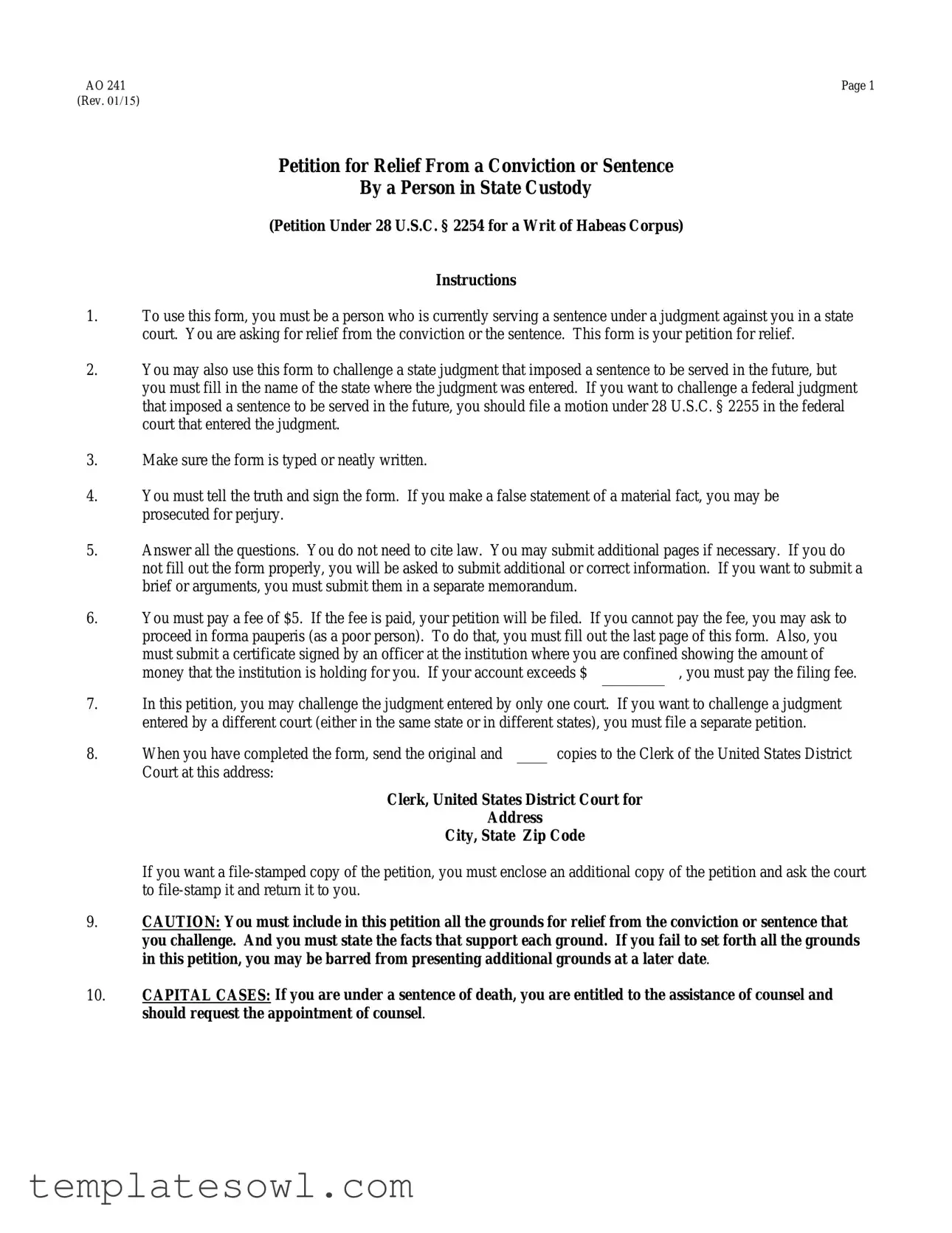AO 241 |
Page 1 |
(Rev. 01/15) |
|
Petition for Relief From a Conviction or Sentence
By a Person in State Custody
(Petition Under 28 U.S.C. § 2254 for a Writ of Habeas Corpus)
Instructions
1.To use this form, you must be a person who is currently serving a sentence under a judgment against you in a state court. You are asking for relief from the conviction or the sentence. This form is your petition for relief.
2.You may also use this form to challenge a state judgment that imposed a sentence to be served in the future, but you must fill in the name of the state where the judgment was entered. If you want to challenge a federal judgment that imposed a sentence to be served in the future, you should file a motion under 28 U.S.C. § 2255 in the federal court that entered the judgment.
3.Make sure the form is typed or neatly written.
4.You must tell the truth and sign the form. If you make a false statement of a material fact, you may be prosecuted for perjury.
5.Answer all the questions. You do not need to cite law. You may submit additional pages if necessary. If you do not fill out the form properly, you will be asked to submit additional or correct information. If you want to submit a brief or arguments, you must submit them in a separate memorandum.
6.You must pay a fee of $5. If the fee is paid, your petition will be filed. If you cannot pay the fee, you may ask to proceed in forma pauperis (as a poor person). To do that, you must fill out the last page of this form. Also, you must submit a certificate signed by an officer at the institution where you are confined showing the amount of
money that the institution is holding for you. If your account exceeds $ |
|
, you must pay the filing fee. |
|
|
|
7.In this petition, you may challenge the judgment entered by only one court. If you want to challenge a judgment entered by a different court (either in the same state or in different states), you must file a separate petition.
8. |
When you have completed the form, send the original and |
|
copies to the Clerk of the United States District |
|
Court at this address: |
|
|
Clerk,Clerk,UnitedUnitedStatesStatesDistrictDistrictCourt forCourt for
AddressAddress
City, City,State StateZip CodeZip Code
If you want a file-stamped copy of the petition, you must enclose an additional copy of the petition and ask the court to file-stamp it and return it to you.
9.CAUTION: You must include in this petition all the grounds for relief from the conviction or sentence that you challenge. And you must state the facts that support each ground. If you fail to set forth all the grounds in this petition, you may be barred from presenting additional grounds at a later date.
10.CAPITAL CASES: If you are under a sentence of death, you are entitled to the assistance of counsel and should request the appointment of counsel.
AO 241 |
Page 2 |
(Rev. 01/15) |
|
PETITION UNDER 28 U.S.C. § 2254 FOR WRIT OF
HABEAS CORPUS BY A PERSON IN STATE CUSTODY
United States District Court
Name (under which you were convicted):
District:
Docket or Case No.:
Petitioner (include the name under which you were convicted) |
Respondent (authorized person having custody of petitioner) |
v.
The Attorney General of the State of:
PETITION
1.(a) Name and location of court that entered the judgment of conviction you are challenging:
(b)Criminal docket or case number (if you know):
2.(a) Date of the judgment of conviction (if you know):
(b)Date of sentencing:
3.Length of sentence:
4. |
In this case, were you convicted on more than one count or of more than one crime? ’ Yes |
’ No |
5.Identify all crimes of which you were convicted and sentenced in this case:
6.(a) What was your plea? (Check one)
’ |
(1) |
Not guilty |
’ |
(3) |
Nolo contendere (no contest) |
’ |
(2) |
Guilty |
’ |
(4) |
Insanity plea |
AO 241 |
Page 3 |
(Rev. 01/15) |
|
(b)If you entered a guilty plea to one count or charge and a not guilty plea to another count or charge, what did you plead guilty to and what did you plead not guilty to?
(c) If you went to trial, what kind of trial did you have? (Check one)
’ Jury ’ Judge only
7.Did you testify at a pretrial hearing, trial, or a post-trial hearing?
’ Yes ’ No
8.Did you appeal from the judgment of conviction?
’ Yes ’ No
9.If you did appeal, answer the following:
(a)Name of court:
(b)Docket or case number (if you know):
(c)Result:
(d)Date of result (if you know):
(e)Citation to the case (if you know):
(f)Grounds raised:
(g) Did you seek further review by a higher state court? |
’ Yes |
’ No |
If yes, answer the following: |
|
|
(1) |
Name of court: |
|
|
(2) |
Docket or case number (if you know): |
|
|
(3) |
Result: |
|
|
|
|
|
|
|
(4) Date of result (if you know):
AO 241 |
Page 4 |
(Rev. 01/15) |
|
(5)Citation to the case (if you know):
(6)Grounds raised:
(h) Did you file a petition for certiorari in the United States Supreme Court? |
’ Yes |
’ No |
If yes, answer the following: |
|
|
(1)Docket or case number (if you know):
(2)Result:
(3)Date of result (if you know):
(4)Citation to the case (if you know):
10.Other than the direct appeals listed above, have you previously filed any other petitions, applications, or motions
concerning this judgment of conviction in any state court? |
’ Yes |
’ No |
11.If your answer to Question 10 was "Yes," give the following information:
(a)(1) Name of court:
(2)Docket or case number (if you know):
(3)Date of filing (if you know):
(4)Nature of the proceeding:
(5)Grounds raised:
(6)Did you receive a hearing where evidence was given on your petition, application, or motion?
’Yes ’ No
(7)Result:
(8)Date of result (if you know):
AO 241 |
Page 5 |
(Rev. 01/15) |
|
(b)If you filed any second petition, application, or motion, give the same information:
(1)Name of court:
(2)Docket or case number (if you know):
(3)Date of filing (if you know):
(4)Nature of the proceeding:
(5)Grounds raised:
(6)Did you receive a hearing where evidence was given on your petition, application, or motion?
’Yes ’ No
(7)Result:
(8)Date of result (if you know):
(c)If you filed any third petition, application, or motion, give the same information:
(1)Name of court:
(2)Docket or case number (if you know):
(3)Date of filing (if you know):
(4)Nature of the proceeding:
(5)Grounds raised:
AO 241 |
Page 6 |
(Rev. 01/15) |
|
(6)Did you receive a hearing where evidence was given on your petition, application, or motion?
’Yes ’ No
(7)Result:
(8)Date of result (if you know):
(d)Did you appeal to the highest state court having jurisdiction over the action taken on your petition, application, or motion?
(1) |
First petition: |
’ Yes |
’ |
No |
(2) |
Second petition: |
’ Yes |
’ |
No |
(3) |
Third petition: |
’ Yes |
’ |
No |
(e)If you did not appeal to the highest state court having jurisdiction, explain why you did not:
12.For this petition, state every ground on which you claim that you are being held in violation of the Constitution, laws, or treaties of the United States. Attach additional pages if you have more than four grounds. State the facts supporting each ground.
CAUTION: To proceed in the federal court, you must ordinarily first exhaust (use up) your available state-court remedies on each ground on which you request action by the federal court. Also, if you fail to set forth all the grounds in this petition, you may be barred from presenting additional grounds at a later date.
GROUND ONE:
(a) Supporting facts (Do not argue or cite law. Just state the specific facts that support your claim.):
(b) If you did not exhaust your state remedies on Ground One, explain why:

AO 241 |
Page 7 |
(Rev. 01/15) |
|
(c)Direct Appeal of Ground One:
(1) If you appealed from the judgment of conviction, did you raise this issue? |
’ Yes |
’ No |
(2)If you did not raise this issue in your direct appeal, explain why:
(d)Post-Conviction Proceedings:
(1)Did you raise this issue through a post-conviction motion or petition for habeas corpus in a state trial court?
’Yes ’ No
(2)If your answer to Question (d)(1) is "Yes," state:
Type of motion or petition:
Name and location of the court where the motion or petition was filed:
Docket or case number (if you know):
Date of the court's decision:
Result (attach a copy of the court's opinion or order, if available):
(3) |
Did you receive a hearing on your motion or petition? |
’ |
Yes |
’ |
No |
(4) |
Did you appeal from the denial of your motion or petition? |
’ |
Yes |
’ |
No |
(5) |
If your answer to Question (d)(4) is "Yes," did you raise this issue in the appeal? |
’ |
Yes |
’ |
No |
(6)If your answer to Question (d)(4) is "Yes," state: Name and location of the court where the appeal was filed:
Docket or case number (if you know):
Date of the court's decision:
Result (attach a copy of the court's opinion or order, if available):
(7) If your answer to Question (d)(4) or Question (d)(5) is "No," explain why you did not raise this issue:
AO 241 |
Page 8 |
(Rev. 01/15) |
|
(e)Other Remedies: Describe any other procedures (such as habeas corpus, administrative remedies, etc.) that you have used to exhaust your state remedies on Ground One:
GROUND TWO:
(a) Supporting facts (Do not argue or cite law. Just state the specific facts that support your claim.):
(b)If you did not exhaust your state remedies on Ground Two, explain why:
(c)Direct Appeal of Ground Two:
(1) If you appealed from the judgment of conviction, did you raise this issue? |
’ Yes |
’ No |
(2)If you did not raise this issue in your direct appeal, explain why:
(d)Post-Conviction Proceedings:
(1)Did you raise this issue through a post-conviction motion or petition for habeas corpus in a state trial court?
’Yes ’ No
(2)If your answer to Question (d)(1) is "Yes," state:
Type of motion or petition:
Name and location of the court where the motion or petition was filed:
Docket or case number (if you know):
Date of the court's decision:
AO 241 |
Page 9 |
(Rev. 01/15) |
|
Result (attach a copy of the court's opinion or order, if available):
(3) |
Did you receive a hearing on your motion or petition? |
’ |
Yes |
’ |
No |
(4) |
Did you appeal from the denial of your motion or petition? |
’ |
Yes |
’ |
No |
(5) |
If your answer to Question (d)(4) is "Yes," did you raise this issue in the appeal? |
’ |
Yes |
’ |
No |
(6)If your answer to Question (d)(4) is "Yes," state: Name and location of the court where the appeal was filed:
Docket or case number (if you know):
Date of the court's decision:
Result (attach a copy of the court's opinion or order, if available):
(7)If your answer to Question (d)(4) or Question (d)(5) is "No," explain why you did not raise this issue:
(e)Other Remedies: Describe any other procedures (such as habeas corpus, administrative remedies, etc.) that you have used to exhaust your state remedies on Ground Two :
GROUND THREE:
(a) Supporting facts (Do not argue or cite law. Just state the specific facts that support your claim.):
AO 241 |
Page 10 |
(Rev. 01/15) |
|
(b)If you did not exhaust your state remedies on Ground Three, explain why:
(c)Direct Appeal of Ground Three:
(1) If you appealed from the judgment of conviction, did you raise this issue? |
’ Yes |
’ No |
(2)If you did not raise this issue in your direct appeal, explain why:
(d)Post-Conviction Proceedings:
(1)Did you raise this issue through a post-conviction motion or petition for habeas corpus in a state trial court?
’Yes ’ No
(2)If your answer to Question (d)(1) is "Yes," state:
Type of motion or petition:
Name and location of the court where the motion or petition was filed:
Docket or case number (if you know):
Date of the court's decision:
Result (attach a copy of the court's opinion or order, if available):
(3) |
Did you receive a hearing on your motion or petition? |
’ |
Yes |
’ No |
(4) |
Did you appeal from the denial of your motion or petition? |
’ |
Yes |
’ No |
(5) |
If your answer to Question (d)(4) is "Yes," did you raise this issue in the appeal? |
’ |
Yes |
’ No |
(6)If your answer to Question (d)(4) is "Yes," state: Name and location of the court where the appeal was filed:
Docket or case number (if you know):
Date of the court's decision:
Result (attach a copy of the court's opinion or order, if available):









